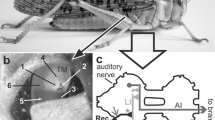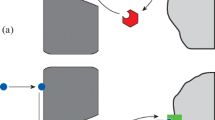Abstract
Electrophysiological parameters were measured at different temperatures in resting and pheromone-stimulated olfactory sensilla trichodea of male Antheraea polyphemus (Saturniidae). A method for selective cooling of either the olfactory hair or the antennal branch was developed.
The resting preparation resistance increased with lower temperatures, the transepithelial potential decreased. These effects were also observed when the antennal branch was cooled, but were absent during cooling the hair, suggesting a major influence of auxiliary cells on the transepithelial potential and resistance. Together with the preparation resistance, the responses to pheromone stimuli increased with lower temperatures.
Computer simulation of the current flow in the sensillum showed that the temperature dependence of responses to pheromone can be explained by modulation of resting resistances of cell membranes alone, without effects of temperature on stimulus transduction. The weak temperature dependence of transepithelial potential might be due to temperature dependence of the electrogenic pump producing the transepithelial potential.
Selective cooling of the olfactory hair had no effect on the shape of nerve impulses, cooling of the antennal branch caused changes similar to that obtained by cooling the entire sensillum. This supports the idea that the nerve impulses are generated in the soma of the receptor cell.
Similar content being viewed by others
Abbreviations
- R prep :
-
preparation resistance
- Δ R prep :
-
reduction of R prep during chemical stimulation
- TEP :
-
transepithelial potential
- Δ TEP :
-
receptor-potential amplitude
- t hd :
-
half-time of decline of the receptor potential
- t hr :
-
half-time of rise of the receptor potential
References
Baur P, Schönherr J (1995) Temperature dependence of the diffusion of organic compounds across plant cuticles. Chemosphere 30: 1331–1340
Bestmann HJ, Dippold K (1989) Temperature dependence of electrophysiological responses of lepidopteran antennae. Z Naturforsch 44c: 333–344
De Kramer JJ (1985) The electrical circuitry of an olfactory sensillum in Antheraea polyphemus. J Neurosci 5: 2484–2493
De Kramer JJ (1986) A study of transduction and structural specialization in insect sensilla. Thesis, University Leiden
Erler G, Thurm U (1981) Dendritic impulse initiation in an epithelial sensory neuron. J Comp Physiol 142: 237–249
Ffrench-Mullen JM, Tokutomi N, Akaike N (1988) The effect of temperature on the GABA-induced chloride current in isolated sensory neurones of the frog. Br J Pharmacol 95: 753–762
French AS (1985) The effects of temperature on action potential encoding in the cockroach tactile spine. J Comp Physiol 156: 817–821
French AS, Kuster JE (1982) The effects of temperature on mechanotransduction in the cockroach tactile spine. J Comp Physiol 147: 251–258
Gnatzy W, Mohren W, Steinbrecht RA (1984) Pheromone receptors in Bombyx mori and Antheraea pernyi II. Morphometric analysis. Cell Tissue Res 235: 35–42
Kaissling K-E (1986a) Chemo-electrical transduction in insect olfactory receptors. Annu Rev Neurosci 9: 121–145
Kaissling K-E (1986b) Temporal characteristics of pheromone receptor cell responses in relation to orientation behaviour of moths. In: Payne TL, Birch MC, Kennedy CEJ (eds) Mechanisms of insect olfaction. University Press, Oxford, pp 193–200
Kaissling K-E (1987) R. H. Wright lectures on insect olfaction. Colbow K (ed) Simon Fraser University, Burnaby
Kaissling K-E (1995a) Pheromone deactivation on the antenna of the moth Antheraea polyphemus: Its minimum velocity and its possible mechanisms. In: Elsner E, Menzel R (eds) Proc 23rd Göttingen Neurobiol Conf vol II. Thieme, Stuttgart, p 362
Kaissling K-E (1995b) Single unit and electroantennogram recordings in insect olfactory organs. In: Spielman AI, Brand JG (eds) Experimental cell biology of taste and olfaction. Current techniques and protocols. CRC Press, Boca Raton New York London Tokyo, pp 361–377
Kaissling K-E, Boekhoff I (1993) Transduction and intracellular messengers in pheromone receptor cells of the moth Antheraea polyphemus. In: Wiese K, Gribakin FG, Popov AV, Renninger G (eds) Sensory systems of arthropods. Birkhäuser, Basel Boston Berlin, pp 489–502
Kaissling K-E, Thorson J (1980) Insect olfactory sensilla: structural, chemical and electrical aspects of the functional organization. In: Sattelle DB, Hall LM, Hildebrand JG (eds) Receptors for neurotransmitters, hormones and pheromones in insects. Elsevier, Amsterdam, pp 261–282
Kaplan JN, Kenney LJ (1985) Temperature effects on sodium pump phosphoenzyme distribution in human red blood cells. J Gen Physiol 85: 123–136
Keil TA (1984) Reconstruction and morphometry of silkmoth olfactory hairs: A comparative study of sensilla trichodea on the antennae of male Antheraea polyphemus and Antheraea pernyi (Insecta, Lepidoptera). Zoomorphology 104: 147–156
Klein U, Zimmermann B (1991) The vacuolar type ATPase from insect plasma membrane: immunocytochemical localization in insect sensilla. Cell Tissue Res 266: 265–273
Kodadová N (1992) Temperature influence on the olfactory sensillum in Antheraea polyphemus. Chem Senses 17: 852
Krasilnikov OV, Sabirov RZ (1989) Ion transport through channels formed in lipid bilayers by Staphylococcus aureus alpha-toxin. Gen Physiol Biophys 8: 213–222
Lullies H (1975) Kurzgefasstes Lehrbuch der Physiologie. Keidel WD (ed). Thieme, Stuttgart
Meng LZ, Wu CH, Wicklein M, Kaissling K-E, Bestmann HJ (1989) Number and distribution of three types of pheromone receptor cells in Antheraea pernyi and A. polyphemus. J Comp Physiol 165: 139–146
Morita H (1972) Primary processes of insect chemoreception. Adv Biophys 3: 161–198
Quartararo N, Barry PH (1988) Ion permeation through single ACh-activated channels in denervated adult toad Sartorius skeletal muscle fibres: effect of temperature. Pflügers Arch 411: 101–112
Redkozubov A (1995) High electrical resistance of the bombykol cell in an olfactory sensillum of Bombyx mori: Voltage- and currentclamp analysis. J Insect Physiol 41: 451–455
Romey G, Chicheportiche R, Ladzunski M (1980) Transition temperatures of the electrical activity of ion channels in the nerve membrane. Biochim Biophys Acta 602: 610–620
Souhrada M, Souhrada JF (1985) Role of electrogenic Na+ pump in the response of sensitized airway smooth muscle to antigen. Respiration 48: 37–45
Tateda H, Morita H (1959) Initiation of spike potentials in contact chemosensory hairs of insects I. The generation of the recorded spike potentials. J Cell Comp Physiol 54: 171–176
Thurm U (1974) Basics of the generation of receptor potentials in epidermal mechanoreceptors of insects. Abh Rheinisch-Westf Akad Wiss 53: 355–385
Wieczorek H (1992) The insect V-ATPase, a plasma membrane proton pump energizing secondary active transport: molecular analysis of electrogenic potassium transport in the tobacco hornworm midgut. J Exp Biol 172: 335–343
Wondergem R, Castillo LB (1986) Effect of temperature on transmembrane potential of mouse liver cells. Am J Physiol 251: 603–613
Yokohari F, Tateda H (1976) Moist and dry hygroreceptors for relative humidity of the cockroach, Periplaneta americana L. J Comp Physiol 106: 137–152
Zack C (1979) Sensory adaptation in the sex pheromone receptor cells of saturniid moths Dissertation, Ludwig-MaximiliansUniversität München
Ziegelberger G (1995) Redox-shift of the pheromone-binding protein in the silkmoth Antheraea polyphemus. Eur J Biochem 232: 706–711
Author information
Authors and Affiliations
Rights and permissions
About this article
Cite this article
Kodadová, B., Kaissling, K.E. Effects of temperature on silkmoth olfactory responses to pheromone can be simulated by modulation of resting cell membrane resistances. J Comp Physiol A 179, 15–27 (1996). https://doi.org/10.1007/BF00193431
Accepted:
Issue Date:
DOI: https://doi.org/10.1007/BF00193431




